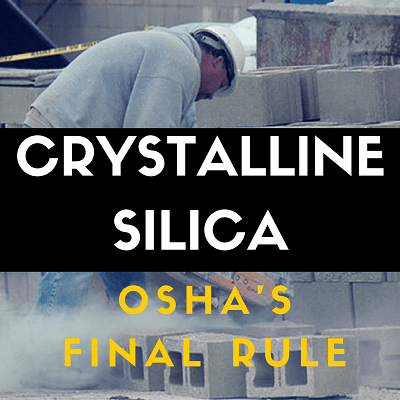OSHA Final Rule on Respirable Silica Exposure
Written by Staff Writer

On March 25, 2016, the Occupational Safety and Health Administration (OSHA) released a Final Rule on Occupational Exposure to Respirable Crystalline Silica. The 2016 update made changes to two of OSHA's standards. For construction workers, the rule is found in 1926.1153(k). An equivalent standard for general industry is found in 1910.1053(l).
This article discusses the important details of OSHA respirable crystalline silica standards and what the rules mean for workers.
What Is Crystalline Silica and Why Is It Dangerous?
Crystalline silica is an abundant natural component of sand, stone, soil, concrete, brick, mortar, quartz and other construction materials. As workers cut, grind, drill, crush or otherwise alter these materials during construction work, they may be exposed to respirable, airborne silica particles. General or maritime industry workers can also experience respirable silica exposure from abrasive blasting or during manufacturing or maintenance. These particles can penetrate deep into lungs and have been found to cause dangerous and often fatal diseases including silicosis, lung cancer, chronic obstructive pulmonary disease and kidney disease.
Silicosis is a disease specifically caused by these silica particles for which there is no cure. Exposure to silica dust results in the formation of fibrosis or scar tissue formations in the lungs. Early stages of silicosis may go completely unnoticed, but routine exposure can cause symptoms such as shortness of breath, fever, chest pain, fatigue, respiratory failure, and/or eventually death. Silicosis also makes the exposed worker susceptible to other infectious lung diseases like tuberculosis. Early detection of silicosis is vital to saving lives and preventing further exposure.
OSHA's Crystalline Silica Final Ruling
The Final Rule and its attendant updates were designed to save lives and prevent new cases of silicosis resulting from workplace exposure.
The Final Rule:
- Set the permissible exposure limit (PEL) for respirable silica to 50 micrograms per cubic meter of air, averaged over an 8-hour shift.
- Requires employers to:
- Use engineering controls (such as water or ventilation) to limit respirable silica exposure
- Provide respirators when engineering controls cannot adequately limit exposure under the PEL
- Limit worker access to high-exposure areas
- Develop a written silica exposure control plan
- Offer medical exams to highly exposed workers
- Train workers on silica hazards, risks and methods of limiting exposure
- Provides medical exams to monitor highly exposed workers and gives them information about their lung health.
- Provides flexibility to help employers (especially small businesses) protect workers from silica exposure.
The easiest way to reduce exposure to crystalline silica is through the careful design of robust controls followed by diligent maintenance. Workplaces can stay within OSHA's permissible exposure limits by focusing on preventive measures rather than catching up with out-of-control exposure.
The Future of Silica Safety
Most employers will be able to comply with the new regulations by using equipment found in local hardware stores; one of the best ways to limit silica exposure is by using water to minimize airborne dust or by using a ventilation system to catch silica particulate. Personal Protective Equipment is also an important element of silica safety for workers performing tasks that may produce respirable silica.
Remember that OSHA rules are subject to change. Workers and employers alike can always check on the current rules for crystalline silica one the OSHA website. With the serious nature of silica-related diseases, everyone in construction and general industry roles should stay up to date on best practices for prevention and mitigation.
In the end, the responsibility for silica safety lies in the hands of employers. By the time OSHA recognizes that a regulation has not been followed by a company, employees can already be in grave danger of fatal respiratory consequences.
